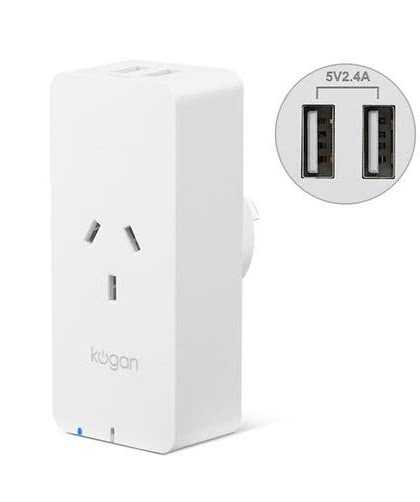devices.esphome.io
Kogan SmarterHome Smart Plug With Energy Meter and 5V 2.4A USB Ports
Kogan SmarterHome Smart Plug With Energy Meter and 5V 2.4A USB Ports
Device Type: plugElectrical Standard: auBoard: esp8266

https://www.kogan.com/au/buy/kogan-smarterhome-smart-plug-energy-meter-5v-24a-usb-ports/
GPIO Pinout
| Pin | Function |
|---|---|
| GPIO03 | Push Button |
| GPIO13 | Green LED (Inverted: true) |
| GPIO14 | Relay |
| GPIO12 | HLW8012 SEL Pin |
| GPIO04 | HLW8012 CF Pin |
| GPIO05 | HLW8012 CF1 Pin |
Basic Config
substitutions: device_name: kogan_plug_1 device_ip: 192.168.x.x device_icon: mdi:power-socket-au device_restore: ALWAYS_ON # Higher value gives lower watt readout current_res: "0.00225" # Lower value gives lower voltage readout voltage_div: "805"
esphome: name: ${device_name}
esp8266: board: esp8285
wifi: ssid: !secret wifi_ssid password: !secret wifi_password
logger: api: reboot_timeout: 15min encryption: key: !secret encryption_key
ota: password: !secret ota_password
binary_sensor: - platform: gpio pin: number: 03 mode: INPUT_PULLUP inverted: true name: "${device_name}_button" on_press: - switch.toggle: relay
- platform: status name: "${device_name}_status"
switch: - platform: gpio id: led pin: number: GPIO13 inverted: true
- platform: gpio name: "${device_name}_plug" pin: GPIO14 id: relay icon: ${device_icon} restore_mode: ${device_restore} on_turn_on: - switch.turn_on: led on_turn_off: - switch.turn_off: led
sensor: - platform: hlw8012 sel_pin: number: GPIO12 inverted: true cf_pin: GPIO04 cf1_pin: GPIO05 current: name: "${device_name}_current" unit_of_measurement: A voltage: name: "${device_name}_voltage" unit_of_measurement: V power: id: ${device_name}_wattage name: "${device_name}_wattage" unit_of_measurement: W current_resistor: ${current_res} voltage_divider: ${voltage_div} change_mode_every: 8 update_interval: 15s
- platform: total_daily_energy name: "${device_name}_daily_energy" power_id: ${device_name}_wattage filters: - multiply: 0.001 unit_of_measurement: kWh
- platform: wifi_signal name: "${device_name}_rssi" update_interval: 5min
- platform: uptime id: uptime_sensor name: "${device_name}_uptime" update_interval: 5min on_raw_value: then: - text_sensor.template.publish: id: uptime_human state: !lambda |- int seconds = round(id(uptime_sensor).raw_state); int days = seconds / (24 * 3600); seconds = seconds % (24 * 3600); int hours = seconds / 3600; seconds = seconds % 3600; int minutes = seconds / 60; seconds = seconds % 60; return ( (days ? to_string(days) + "d " : "") + (hours ? to_string(hours) + "h " : "") + (minutes ? to_string(minutes) + "m " : "") + (to_string(seconds) + "s") ).c_str();
text_sensor: - platform: template name: "${device_name}_uptime_human" id: uptime_human entity_category: diagnostic icon: mdi:clock-start
time: - platform: homeassistant id: homeassistant_timeAppendix
If you are seeing incorrect power/current readings at higher power draws (i.e. current of 5A@240V while power is showing ~2000W), your unit most likely has a BL0937 chip. You can verify this by looking at underside of the PCB, in the general area of the ESP chip. To get correct sensor results, make the following config changes:
(...)substitutions: current_res: "0.001" # visually verified the shunt resistor is 1m0 voltage_div: "1720" # rough value, tested against multimeter readout(...)sensor: - platform: hlw8012 (...) model: BL0937(...)The readings should be correct from now on.
Edit this page on GitHub